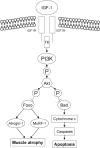Modulation of GH/IGF-1 axis: potential strategies to counteract sarcopenia in older adults
- PMID: 18762207
- PMCID: PMC5992490
- DOI: 10.1016/j.mad.2008.08.001
Modulation of GH/IGF-1 axis: potential strategies to counteract sarcopenia in older adults
Abstract
Aging is associated with progressive decline of skeletal muscle mass and function. This condition, termed sarcopenia, is associated with several adverse outcomes, including loss of autonomy and mortality. Due to the high prevalence of sarcopenia, a deeper understanding of its pathophysiology and possible remedies represents a high public health priority. Evidence suggests the existence of a relationship between declining growth hormone (GH) and insulin-like growth factor-1 (IGF-1) levels and age-related changes in body composition and physical function. Therefore, the age-dependent decline of GH and IGF-1 serum levels may promote frailty by contributing to the loss of muscle mass and strength. Preclinical studies showed that infusion of angiotensin II produced a marked reduction in body weight, accompanied by decreased serum and muscle levels of IGF-1. Conversely, overexpression of muscle-specific isoform of IGF-1 mitigates angiotensin II-induced muscle loss. Moreover, IGF-1 serum levels have been shown to increase following angiotensin converting enzyme inhibitors (ACEIs) treatment. Here we will review the most recent evidence regarding age-related changes of the GH/IGF-1 axis and its modulation by several interventions, including ACEIs which might represent a potential novel strategy to delay the onset and impede the progression of sarcopenia.
Figures


Similar articles
-
Blockade of angiotensin II modulates insulin-like growth factor 1-mediated skeletal muscle homeostasis in experimental steatohepatitis.Biochim Biophys Acta Mol Cell Res. 2024 Feb;1871(2):119649. doi: 10.1016/j.bbamcr.2023.119649. Epub 2023 Dec 12. Biochim Biophys Acta Mol Cell Res. 2024. PMID: 38097064
-
Beneficial effects of GH/IGF-1 on skeletal muscle atrophy and function in experimental heart failure.Am J Physiol Cell Physiol. 2004 Jan;286(1):C138-44. doi: 10.1152/ajpcell.00114.2003. Epub 2003 Sep 17. Am J Physiol Cell Physiol. 2004. PMID: 13679302
-
Effects of single nightly injections of growth hormone-releasing hormone (GHRH 1-29) in healthy elderly men.Metabolism. 1997 Jan;46(1):89-96. doi: 10.1016/s0026-0495(97)90174-8. Metabolism. 1997. PMID: 9005976 Clinical Trial.
-
Exercise and the growth hormone-insulin-like growth factor axis.Med Sci Sports Exerc. 2010 Jan;42(1):58-66. doi: 10.1249/MSS.0b013e3181b07d2d. Med Sci Sports Exerc. 2010. PMID: 20010129 Review.
-
Clinical implications of the reduced activity of the GH-IGF-I axis in older men.J Endocrinol Invest. 2005;28(11 Suppl Proceedings):96-100. J Endocrinol Invest. 2005. PMID: 16760634 Review.
Cited by
-
A Low Free T3 to Free T4 Ratio Is Associated with Sarcopenia in Euthyroid Patients with Type 2 Diabetes Mellitus.J Diabetes Res. 2022 Aug 17;2022:2305156. doi: 10.1155/2022/2305156. eCollection 2022. J Diabetes Res. 2022. PMID: 36034587 Free PMC article.
-
Growth hormone responses to acute resistance exercise with vascular restriction in young and old men.Growth Horm IGF Res. 2012 Oct;22(5):167-72. doi: 10.1016/j.ghir.2012.05.002. Epub 2012 Jun 23. Growth Horm IGF Res. 2012. PMID: 22727808 Free PMC article.
-
Quantitative estimation of muscle mass in older adults at risk of sarcopenia using ultrasound: a cross-sectional study.Quant Imaging Med Surg. 2022 Apr;12(4):2498-2508. doi: 10.21037/qims-21-685. Quant Imaging Med Surg. 2022. PMID: 35371958 Free PMC article.
-
Metabolic impact of adult-onset, isolated, growth hormone deficiency (AOiGHD) due to destruction of pituitary somatotropes.PLoS One. 2011 Jan 19;6(1):e15767. doi: 10.1371/journal.pone.0015767. PLoS One. 2011. PMID: 21283519 Free PMC article.
-
Age and estrogen-based hormone therapy affect systemic and local IL-6 and IGF-1 pathways in women.Age (Dordr). 2012 Oct;34(5):1249-60. doi: 10.1007/s11357-011-9298-1. Epub 2011 Aug 16. Age (Dordr). 2012. PMID: 21845403 Free PMC article.
References
-
- Allen DL, Linderman JK, Roy RR, Grindeland RE, Mukku V, Edgerton VR. Growth hormone/IGF-I and/or resistive exercise maintains myonuclear number in hindlimb unweighted muscles. J Appl Physiol. 1997;83:1857–1861. - PubMed
-
- Andersen NB, Andreassen TT, Orskov H, Oxlund H. Growth hormone and mild exercise in combination increases markedly muscle mass and tetanic tension in old rats. Eur J Endocrinol. 2000;143:409–418. - PubMed
-
- Arvat E, Broglio F, Ghigo E. Insulin-Like growth factor I: implications in aging. Drugs Aging. 2000;16:29–40. - PubMed
-
- Barbieri M, Ferrucci L, Ragno E, Corsi A, Bandinelli S, Bonafe M, Olivieri F, Giovagnetti S, Franceschi C, Guralnik JM, Paolisso G. Chronic inflammation and the effect of IGF-I on muscle strength and power in older persons. Am J Physiol Endocrinol Metab. 2003;284:E481–E487. - PubMed
Publication types
MeSH terms
Substances
Grants and funding
LinkOut - more resources
Full Text Sources
Medical
Miscellaneous

